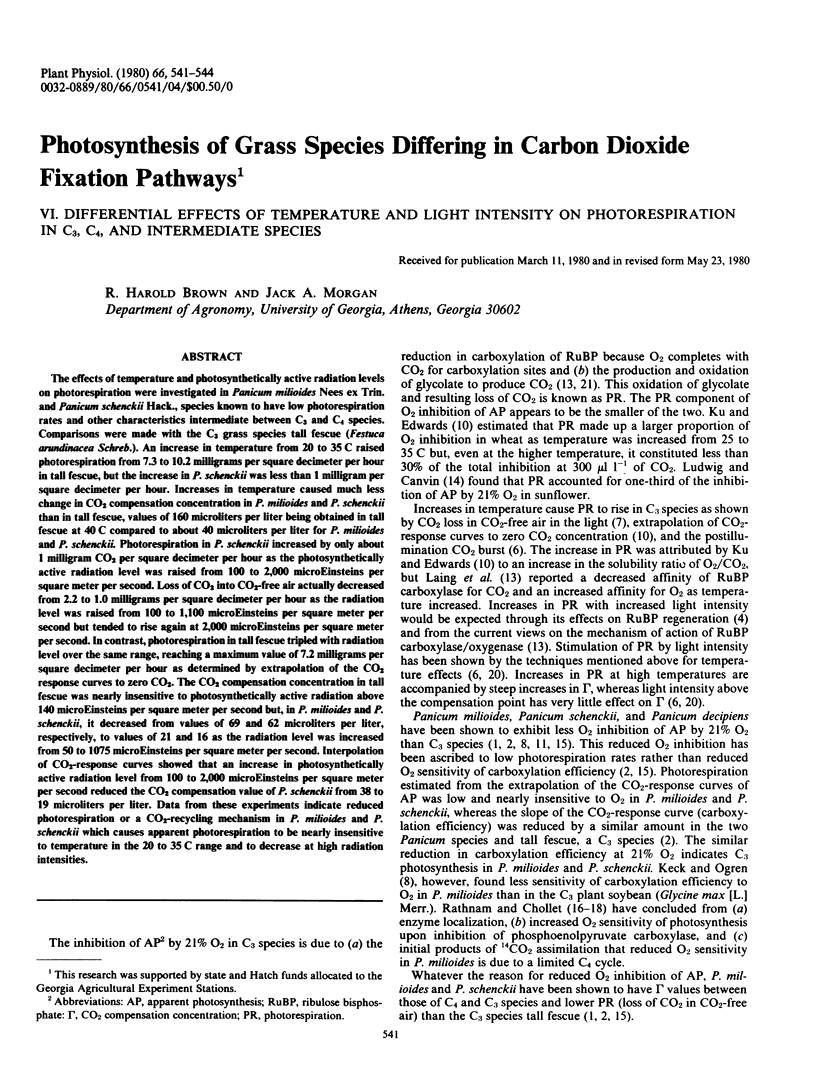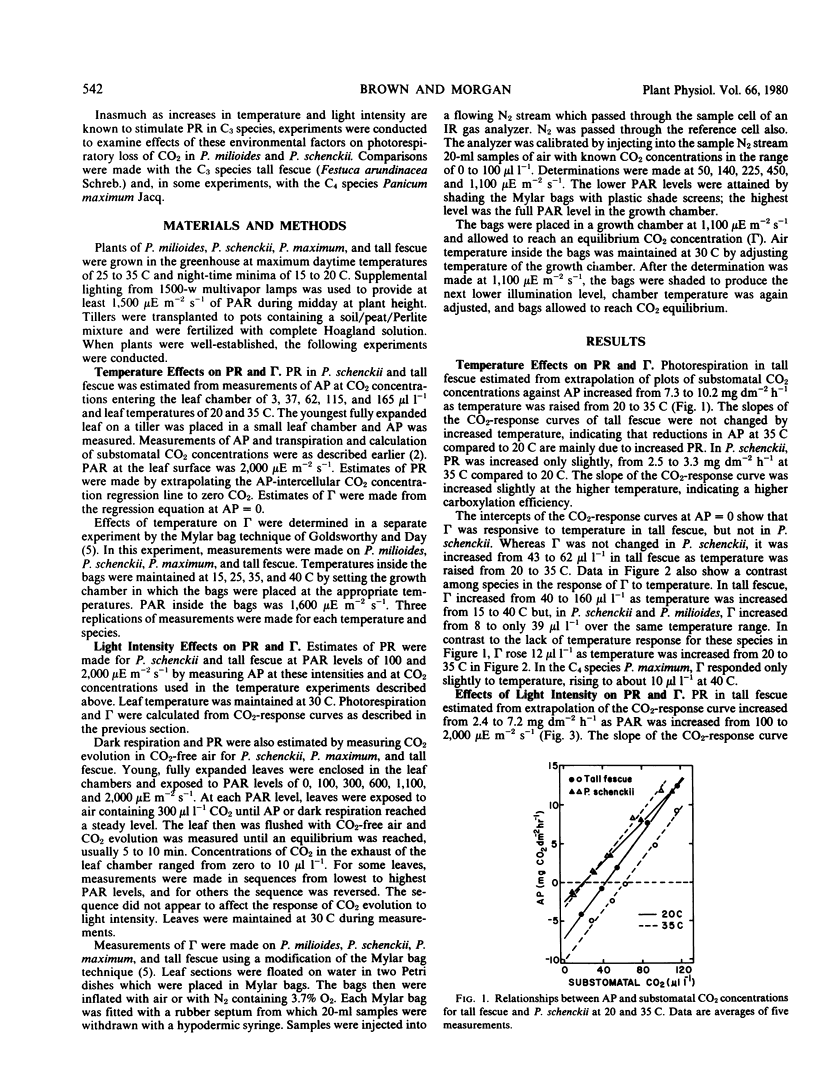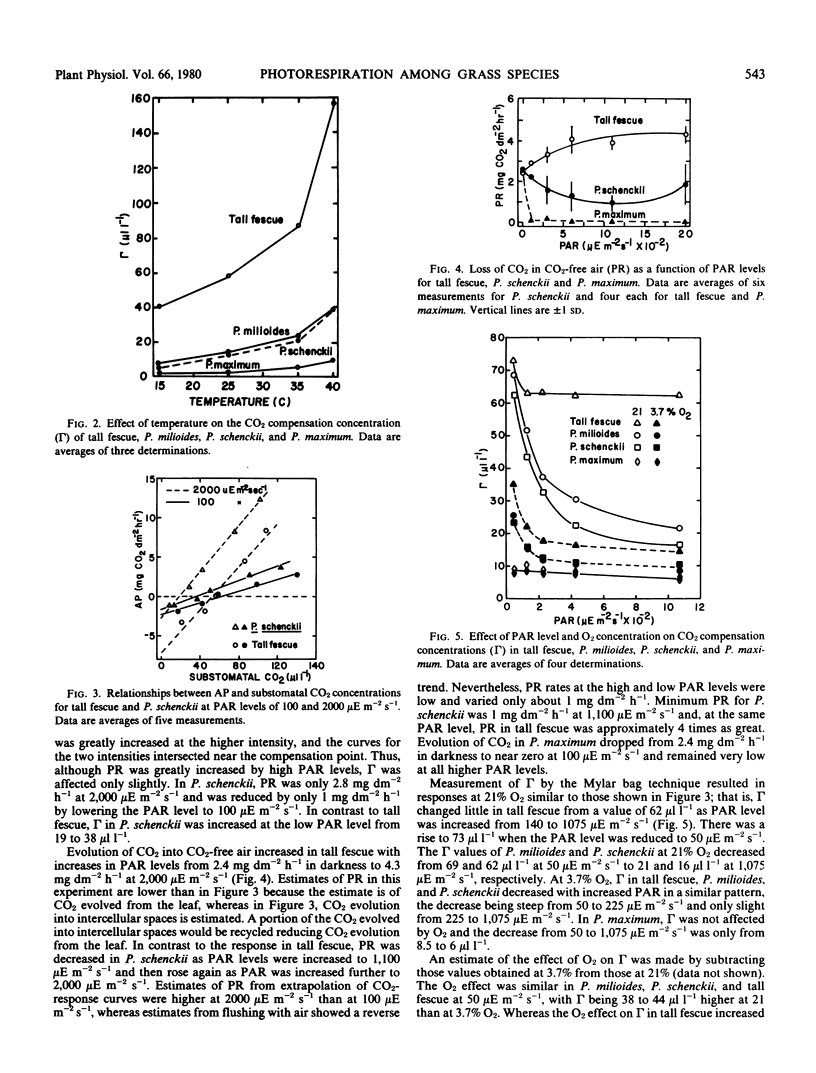Abstract
The effects of temperature and photosynthetically active radiation levels on photorespiration were investigated in Panicum milioides Nees ex Trin. and Panicum schenckii Hack., species known to have low photorespiration rates and other characteristics intermediate between C3 and C4 species. Comparisons were made with the C3 grass species tall fescue (Festuca arundinacea Schreb.). An increase in temperature from 20 to 35 C raised photorespiration from 7.3 to 10.2 milligrams per square decimeter per hour in tall fescue, but the increase in P. schenckii was less than 1 milligram per square decimeter per hour. Increases in temperature caused much less change in CO2 compensation concentration in P. milioides and P. schenckii than in tall fescue, values of 160 microliters per liter being obtained in tall fescue at 40 C compared to about 40 microliters per liter for P. milioides and P. schenckii. Photorespiration in P. schenckii increased by only about 1 milligram CO2 per square decimeter per hour as the photosynthetically active radiation level was raised from 100 to 2,000 microEinsteins per square meter per second. Loss of CO2 into CO2-free air actually decreased from 2.2 to 1.0 milligrams per square decimeter per hour as the radiation level was raised from 100 to 1,100 microEinsteins per square meter per second but tended to rise again at 2,000 microEinsteins per square meter per second. In contrast, photorespiration in tall fescue tripled with radiation level over the same range, reaching a maximum value of 7.2 milligrams per square decimeter per hour as determined by extrapolation of the CO2 response curves to zero CO2. The CO2 compensation concentration in tall fescue was nearly insensitive to photosynthetically active radiation above 140 microEinsteins per square meter per second but, in P. milioides and P. schenckii, it decreased from values of 69 and 62 microliters per liter, respectively, to values of 21 and 16 as the radiation level was increased from 50 to 1075 microEinsteins per square meter per second. Interpolation of CO2-response curves showed that an increase in photosynthetically active radiation level from 100 to 2,000 microEinsteins per square meter per second reduced the CO2 compensation value of P. schenckii from 38 to 19 microliters per liter. Data from these experiments indicate reduced photorespiration or a CO2-recycling mechanism in P. milioides and P. schenckii which causes apparent photorespiration to be nearly insensitive to temperature in the 20 to 35 C range and to decrease at high radiation intensities.
Full text
PDF



Selected References
These references are in PubMed. This may not be the complete list of references from this article.
- Brown R. H. Photosynthesis of Grass Species Differing in Carbon Dioxide Fixation Pathways: IV. ANALYSIS OF REDUCED OXYGEN RESPONSE IN PANICUM MILIOIDES AND PANICUM SCHENCKII. Plant Physiol. 1980 Feb;65(2):346–349. doi: 10.1104/pp.65.2.346. [DOI] [PMC free article] [PubMed] [Google Scholar]
- Goldsworthy A., Day P. R. A Simple Technique for the Rapid Determination of Plant CO(2) Compensation Points. Plant Physiol. 1970 Dec;46(6):850–851. doi: 10.1104/pp.46.6.850. [DOI] [PMC free article] [PubMed] [Google Scholar]
- Keck R. W. Differential Oxygen Response of Photosynthesis in Soybean and Panicum milioides. Plant Physiol. 1976 Oct;58(4):552–555. doi: 10.1104/pp.58.4.552. [DOI] [PMC free article] [PubMed] [Google Scholar]
- Kestler D. P., Mayne B. C., Ray T. B., Goldstein L. D., Brown R. H., Black C. C. Biochemical components of the photosynthetic CO2 compensation point of higher plants. Biochem Biophys Res Commun. 1975 Oct 27;66(4):1439–1446. doi: 10.1016/0006-291x(75)90520-3. [DOI] [PubMed] [Google Scholar]
- Ku S. B., Edwards G. E. Oxygen Inhibition of Photosynthesis: II. Kinetic Characteristics as Affected by Temperature. Plant Physiol. 1977 May;59(5):991–999. doi: 10.1104/pp.59.5.991. [DOI] [PMC free article] [PubMed] [Google Scholar]
- Laing W. A. Regulation of Soybean Net Photosynthetic CO(2) Fixation by the Interaction of CO(2), O(2), and Ribulose 1,5-Diphosphate Carboxylase. Plant Physiol. 1974 Nov;54(5):678–685. doi: 10.1104/pp.54.5.678. [DOI] [PMC free article] [PubMed] [Google Scholar]
- Ludwig L. J., Canvin D. T. The Rate of Photorespiration during Photosynthesis and the Relationship of the Substrate of Light Respiration to the Products of Photosynthesis in Sunflower Leaves. Plant Physiol. 1971 Dec;48(6):712–719. doi: 10.1104/pp.48.6.712. [DOI] [PMC free article] [PubMed] [Google Scholar]
- Morgan J. A., Brown R. H. Photosynthesis in Grass Species Differing in Carbon Dioxide Fixation Pathways: III. OXYGEN RESPONSE AND ENZYME ACTIVITIES OF SPECIES IN THE LAXA GROUP OF PANICUM. Plant Physiol. 1980 Jan;65(1):156–159. doi: 10.1104/pp.65.1.156. [DOI] [PMC free article] [PubMed] [Google Scholar]
- Rathnam C. K., Chollet R. CO2 donation by malate and aspartate reduces photorespiration in Panicum milioides, a C3-C4 intermediate species. Biochem Biophys Res Commun. 1978 Nov 29;85(2):801–808. doi: 10.1016/0006-291x(78)91233-0. [DOI] [PubMed] [Google Scholar]
- Rathnam C. K., Chollet R. Phosphoenolpyruvate carboxylase reduces photorespiration in Panicum milioides, a C3-C4 intermediate species. Arch Biochem Biophys. 1979 Apr 1;193(2):346–354. doi: 10.1016/0003-9861(79)90039-0. [DOI] [PubMed] [Google Scholar]
- Rathnam C. K., Chollet R. Photosynthetic carbon metabolism in Panicum milioides, a C3-C4 intermediate species: evidence for a limited C4 dicarboxylic acid pathway of photosynthesis. Biochim Biophys Acta. 1979 Dec 6;548(3):500–519. doi: 10.1016/0005-2728(79)90061-6. [DOI] [PubMed] [Google Scholar]


